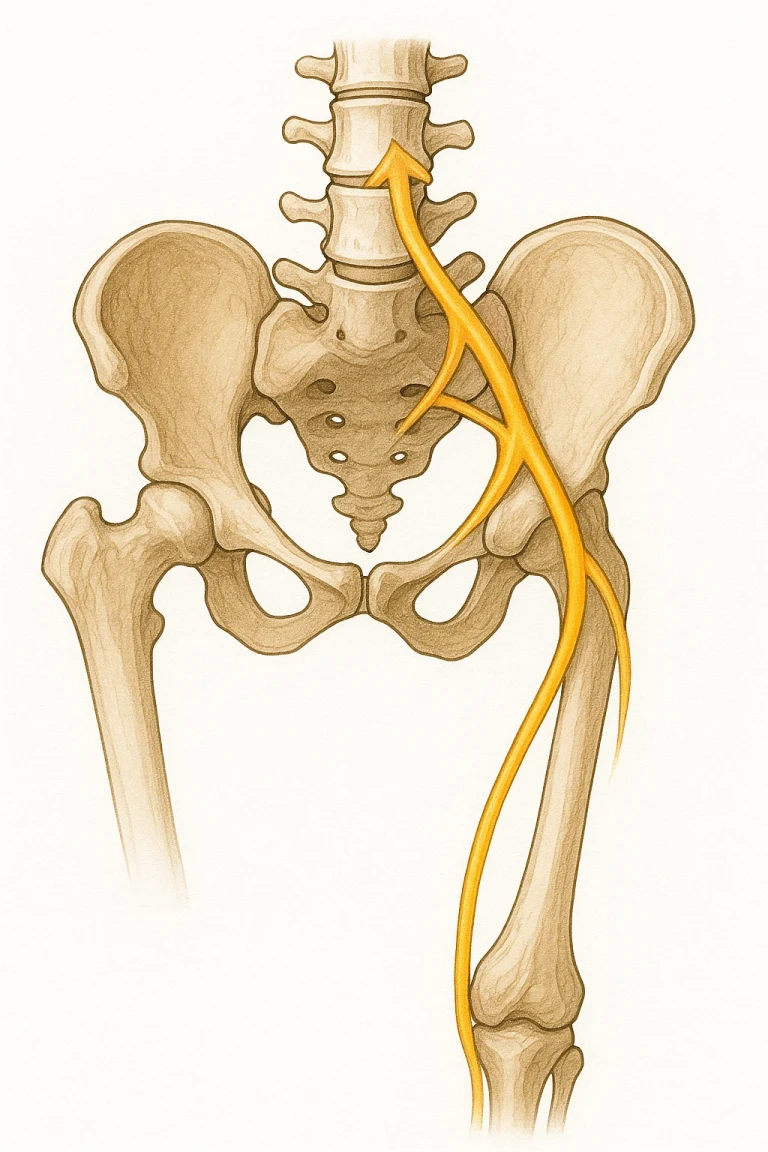
If you've ever experienced sharp, shooting pain that radiates from your lower back down one leg, you're likely familiar with sciatica — a common and often debilitating condition.
Many people search for solutions like "sciatica stretches," "sciatica treatment near me," or "how to relieve sciatic nerve pain fast." But one critical aspect is often overlooked: pelvic alignment.
What Is Sciatica?
Sciatica refers to pain that originates along the sciatic nerve, the largest nerve in the human body. This nerve starts in the lower spine and travels through the pelvis, buttocks, and down each leg.
Sciatica isn’t a diagnosis itself but a symptom of an underlying condition, such as a herniated disc, spinal stenosis, or — as this blog emphasizes — pelvic misalignment.
Common symptoms of sciatica include:
- Sharp or burning pain in the lower back, hip, or leg
- Tingling or numbness in the legs or feet
Muscle weakness - Pain that worsens with sitting or prolonged standing
What Causes Sciatica?
While disc issues are often blamed for sciatica, many patients don’t realize that the alignment of the pelvis plays a foundational role in how the lower back and sciatic nerve function.
Causes of sciatic nerve pain can include:
- Lumbar disc herniation
- Degenerative disc disease
- Piriformis syndrome
- Sacroiliac joint dysfunction
- Pelvic obliquity or rotation
Why Pelvic Alignment Matters
The pelvis acts as the foundation of your spine. When it becomes misaligned — whether due to poor posture, prolonged sitting, pregnancy, repetitive movements, or injury — it creates a chain reaction up and down the body. This imbalance can:
- Alter spinal curvature
- Increase pressure on lumbar discs
- Irritate the sacroiliac (SI) joint
- Cause muscular compensation and nerve entrapment
For example, an anterior pelvic tilt (when the front of the pelvis tilts forward) can tighten the hip flexors, overstress the lumbar spine, and pull on the piriformis muscle — which in turn can compress the sciatic nerve.
Without correcting these imbalances, sciatica pain can persist or keep returning despite temporary relief from medications or basic exercises.
The Chiropractic Approach to Sciatica Relief
Unlike conventional treatment that often focuses on pain management through drugs or surgery, chiropractors look at the body holistically. They evaluate the spine, pelvis, gait, and muscular function to uncover the root cause of sciatic nerve pain.
1. Pelvic and Spinal Adjustments
Chiropractic adjustments help realign the pelvis and spine, reducing abnormal pressure on the sciatic nerve. By restoring proper biomechanics, these adjustments allow the body to function optimally and relieve nerve irritation at its source.
2. Functional Assessments
Chiropractors may perform movement and posture assessments to identify muscle imbalances, joint restrictions, and faulty movement patterns contributing to sciatica.
3. Soft Tissue Work
Muscle tension, especially in the piriformis, glutes, and hamstrings, can contribute to nerve compression. Chiropractors may use myofascial release, trigger point therapy, or instrument-assisted soft tissue mobilization to relieve tightness.
4. Corrective Exercises
A customized rehab program helps retrain muscles around the pelvis and core, improve flexibility, and prevent future flare-ups.
Benefits of Chiropractic Care for Sciatica
Patients who choose chiropractic care for sciatica often report:
- Reduced pain intensity and frequency
- Improved posture and mobility
- Faster recovery without drugs or surgery
- Better understanding of their body mechanics
- Personalized care tailored to their lifestyle and goals
Because chiropractic care focuses on the cause, not just symptom suppression, it often leads to longer-lasting relief and improved overall function.
Frequently Asked Questions About Sciatica and Chiropractic
Is chiropractic safe for sciatica?
Yes. Chiropractic care is non-invasive and drug-free. Chiropractors are trained to safely assess and treat nerve-related conditions, including sciatica.
How many sessions will I need?
Treatment plans vary based on the severity and underlying cause, but many patients begin to feel relief within a few visits. A typical care plan may include 6–12 sessions combined with home exercises.
Can chiropractic prevent sciatica from coming back?
Absolutely. By correcting pelvic misalignment and improving movement patterns, chiropractic care helps prevent recurrence.
What should I do if I think I have sciatica?
Avoid self-diagnosing or relying solely on painkillers. Schedule a visit with a chiropractor who can properly assess your spine and pelvis and create a care plan designed for your body.
When to See a Chiropractor for Sciatica
If you're experiencing any of the following, it's time to consider chiropractic care:
- Pain that radiates down one leg
- Difficulty sitting, standing, or walking without discomfort
- Repeated flare-ups of lower back or hip pain
- Numbness or tingling in the lower extremities
A desire to avoid surgery or long-term medication
Healing Sciatica Starts at the Foundation
If you’ve been chasing the symptoms of sciatica without relief, it might be time to look deeper — and lower — into your pelvis. Misalignments in this region often go unnoticed but are a major driver of sciatic nerve irritation.
With chiropractic care, you’re not just masking pain — you’re restoring balance, alignment, and function.







Leave a comment